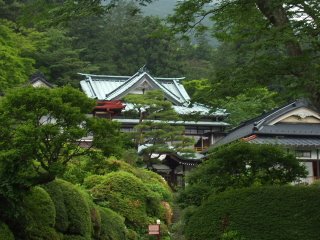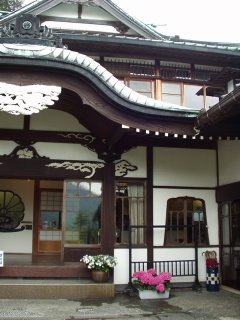Mikawaya Ryokan (Hakone, Japan)
 I just came back from a trip to an onsen, a hot spring resort, with my 75 year old mother.
I just came back from a trip to an onsen, a hot spring resort, with my 75 year old mother.Anyone who's been here knows how the Japanese, despite their outward pride in their traditions, really don't care much about the past. I think that's one of the reasons why they don't teach history properly in their schools. It's a shame (and it shames me -- especially the official attitudes towards the atrocities that happened during Japan's military rule), but deep down, most people think "What's the big deal? It's the past. We've moved on." I don't understand how you can move on without confronting the truth. At the same time, I do understand that this "always moving forward" IS Japan's energy. So while many cities around the world take great care in preserving its architecture, Tokyoites feel nothing about razing landmarks to create new ones.

Between the time I was here last and this time, Omotesando has undergone a huge "renewal." That's a word they love to use. There used to be an apartment complex midway down Omotesando called the Dojunkai Apartments. They were built just before the Tokyo Olympics in 1964 to house participating athletes and then were used as apartments. For the last several decades, these apartments were mostly tiny shops and galleries. They're no longer there. Replaced, instead, by a truly ugly new "Omotesando Hills," another feather in the cap of the Mori Building Empire. A friend of mine who works for Mr. Mori occasionally told me, "but the Dojunkai Apartments were no longer safe!" when I told her how ugly I thought the new complex was and what a shame they had to tear down the old buildings. I can't believe that with Japan's advanced technology and Mori's massive wealth that they couldn't have done something to preserve the exterior of the old buildings and still make it earthquake proof.
 Everywhere you look, there is construction going on. Tokyo's skyline is constantly changing, always unfinished. The unfinished construction of buildings in rural Mexico and the Philippines, those concrete block buildings with re-bar sticking out of roofs, always amuse Big Dog and me, and I used to say that even though they were not pretty, they looked like little prayers for a better future. The re-bar was there so you could add more floors as the family became wealthier or bigger. There is no exposed re-bar in Japanese buildings, but the steel frames, the construction cranes, the always-something-under-construction sights here are just plain ugly and feel more like hubris than "little prayers."
Everywhere you look, there is construction going on. Tokyo's skyline is constantly changing, always unfinished. The unfinished construction of buildings in rural Mexico and the Philippines, those concrete block buildings with re-bar sticking out of roofs, always amuse Big Dog and me, and I used to say that even though they were not pretty, they looked like little prayers for a better future. The re-bar was there so you could add more floors as the family became wealthier or bigger. There is no exposed re-bar in Japanese buildings, but the steel frames, the construction cranes, the always-something-under-construction sights here are just plain ugly and feel more like hubris than "little prayers." Thus, it was especially delightful to get out of Tokyo and go to an onsen ryokan, a hot spring inn, that had been in business since the Meiji Era! Mikawaya Ryokan is a gorgeous, 123 year old ryokan set in the hills of Hakone. Everyone there was so gracious and subtly attentive. And at night, my mother and I shuffled down to a park across the street in our yukata, to see fireflies! Real ones! (At the Four Seasons/Chinzanso Hotel in Tokyo, you can also see fireflies, but they are specially bred ones. I don't think there are any naturally existing fireflies in Tokyo anymore.) Fragile, pulsing neon green fairies, the male fireflies light up their butts to court the females.
Thus, it was especially delightful to get out of Tokyo and go to an onsen ryokan, a hot spring inn, that had been in business since the Meiji Era! Mikawaya Ryokan is a gorgeous, 123 year old ryokan set in the hills of Hakone. Everyone there was so gracious and subtly attentive. And at night, my mother and I shuffled down to a park across the street in our yukata, to see fireflies! Real ones! (At the Four Seasons/Chinzanso Hotel in Tokyo, you can also see fireflies, but they are specially bred ones. I don't think there are any naturally existing fireflies in Tokyo anymore.) Fragile, pulsing neon green fairies, the male fireflies light up their butts to court the females."Look at my butt! Look at my butt!"
"Oooo. I like the shine of your butt! Let's do it!"
Besides the wonderfully soothing hot spring baths and the carefully crafted kaiseki dinner, I just loved being inside the centuries old building. In a land of constant change, it was soothing to be able to touch, physically, something that old. A wonderful experience for me in my last few days in Japan.



0 Comments:
Post a Comment
<< Home